
Chapter 1. Chapter 10: Mutations and Cancer
1.1 Introduction

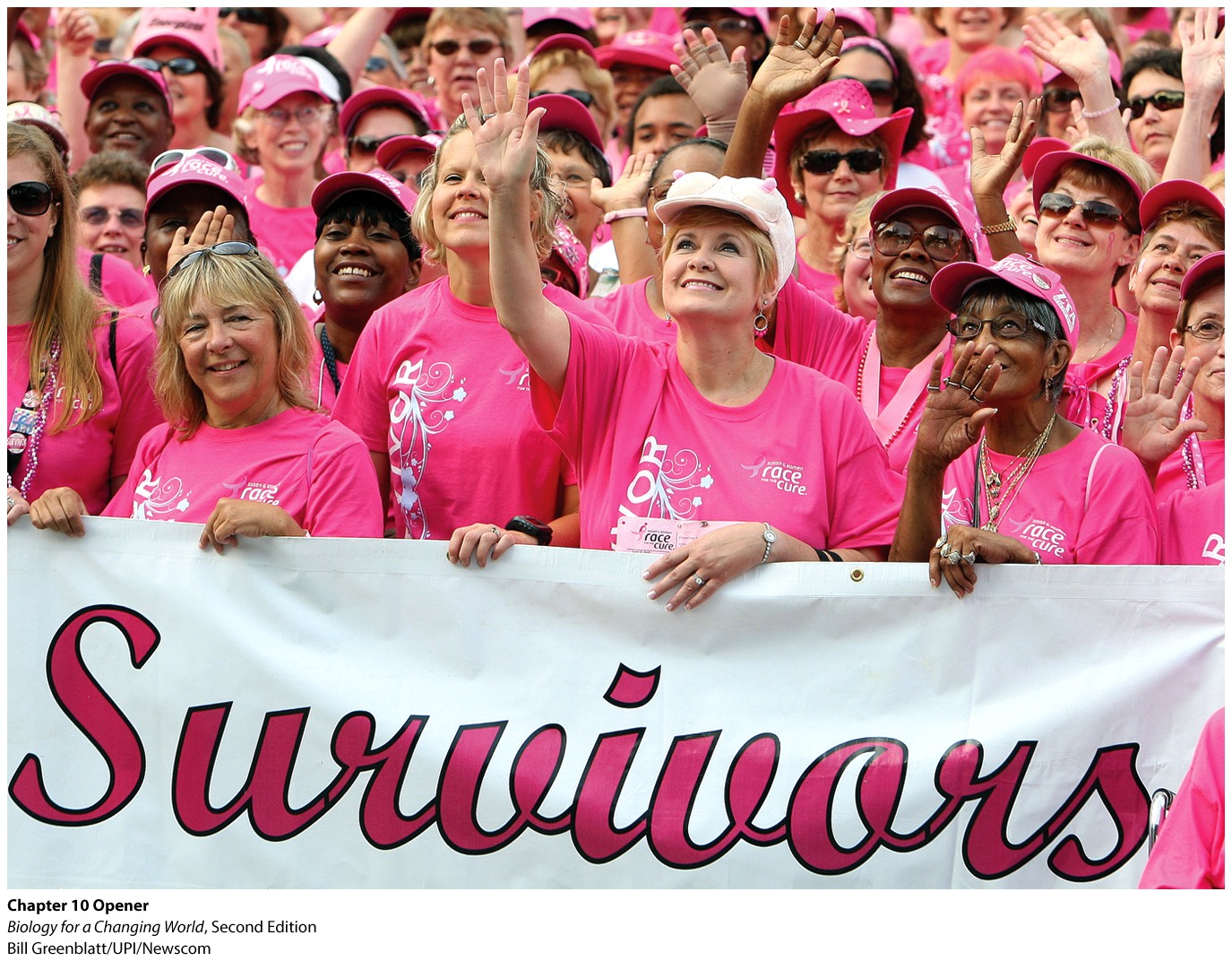
Welcome to the Interactive Study Guide for Chapter 10: Mutations and Cancer. This Study Guide will help you master your understanding of the chapter's Driving Questions, using interactive Infographics and activities, as well as targeted assessment questions. Click "Next" to get started, or select a Driving Question from the drop-down menu to the right.
Fighting Fate:
When cancer runs in the family, ordinary measures are not enough
DRIVING QUESTIONS
- What are mutations and how can they occur?
- How does cancer develop and how can people reduce their risk?
- Why do people with “inherited” cancer often develop cancer at a relatively young age?
1.2 Driving Question 1
Driving Question 1
What are mutations and how can they occur?
Why should you care?
Some mutations may be caused by mistakes made during DNA replication that aren’t repaired by normal cellular mechanisms. Even though such mistakes are very rare during each replication event, replication itself is so frequent that mutations add up over time. Mutations give rise to new alleles – i.e., alternative forms of a gene that can be passed from parent to offspring.
For most women, the risk of developing breast cancer is 12-15% (1 in 7 women). For women with a mutation in the BRCA1 gene, however, the lifetime risk of developing breast cancer is 40-80%. Moreover, the mutation also creates a 20-50% lifetime risk of developing ovarian cancer. The mutation is hereditary and involves only a small change in the normal BRCA1 DNA sequence.
Lorene Ahern inherited her mutated BCRA1 allele from one of her parents. But mutations – including those that increase cancer risk – can be caused in other ways as well. Understanding the causes of mutations can help us make wise lifestyle choices that can reduce our own cancer risks.
What should you know?
To fully answer this Driving Question, you should be able to:
- Compare and contrast the normal BRCA1 allele with the allele that increases the risk of breast and ovarian cancer.
- Illustrate and describe how errors in DNA replication and repair can result in mutations.
- Compare and contrast the three different ways in which DNA mutations may be acquired.
- Predict whether a mutation in the DNA of different parental cells will be inherited by their offspring.
Infographic Focus
The infographics most pertinent to the Driving Question are 10.1, 10.2, 10.3, 10.4 and 10.5.
Test Your Vocabulary
Choose the correct term for each of the following definitions:
| Term | Definition |
|---|---|
| A mutation occurring in gametes; passed on to offspring. | |
| Any chemical agent that causes cancer by damaging DNA. Carcinogens are a type of mutagen. | |
| Any chemical or physical agent that can damage DNA by changing its nucleotide sequence. | |
| A change in the nucleotide sequence of DNA. | |
| A mutation that occurs in a body (nongamete) cell; not passed on to offspring. |
Compare and contrast the normal BRCA1 allele with the allele that increases the risk of breast and ovarian cancer.
1.
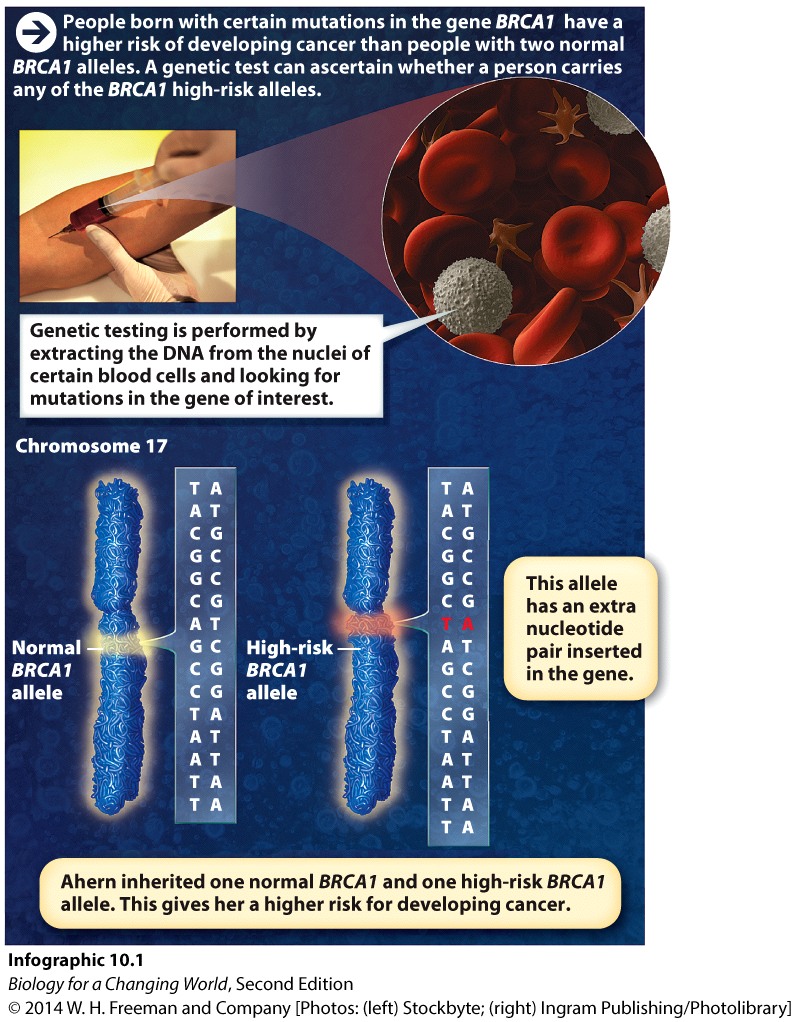
Compare the DNA sequences shown in Infographic 10.1 for the normal and mutated BRCA1 alleles. Based on your understanding of transcription and translation, how different would the proteins produced by these two alleles be? (Review Ch. 8 as necessary, with particular attention to the structure of mRNA codons and how they code for amino acids.)
Describe how errors in DNA replication and repair can result in mutations.
2.
Describe the three possible outcomes of a mistake at a single nucleotide during DNA replication.
3.
Based on your answer, how would you explain to someone with a limited understanding of genetics the relationship between mutations and alleles?
Compare and contrast the three different ways in which DNA mutations may arise.
4.
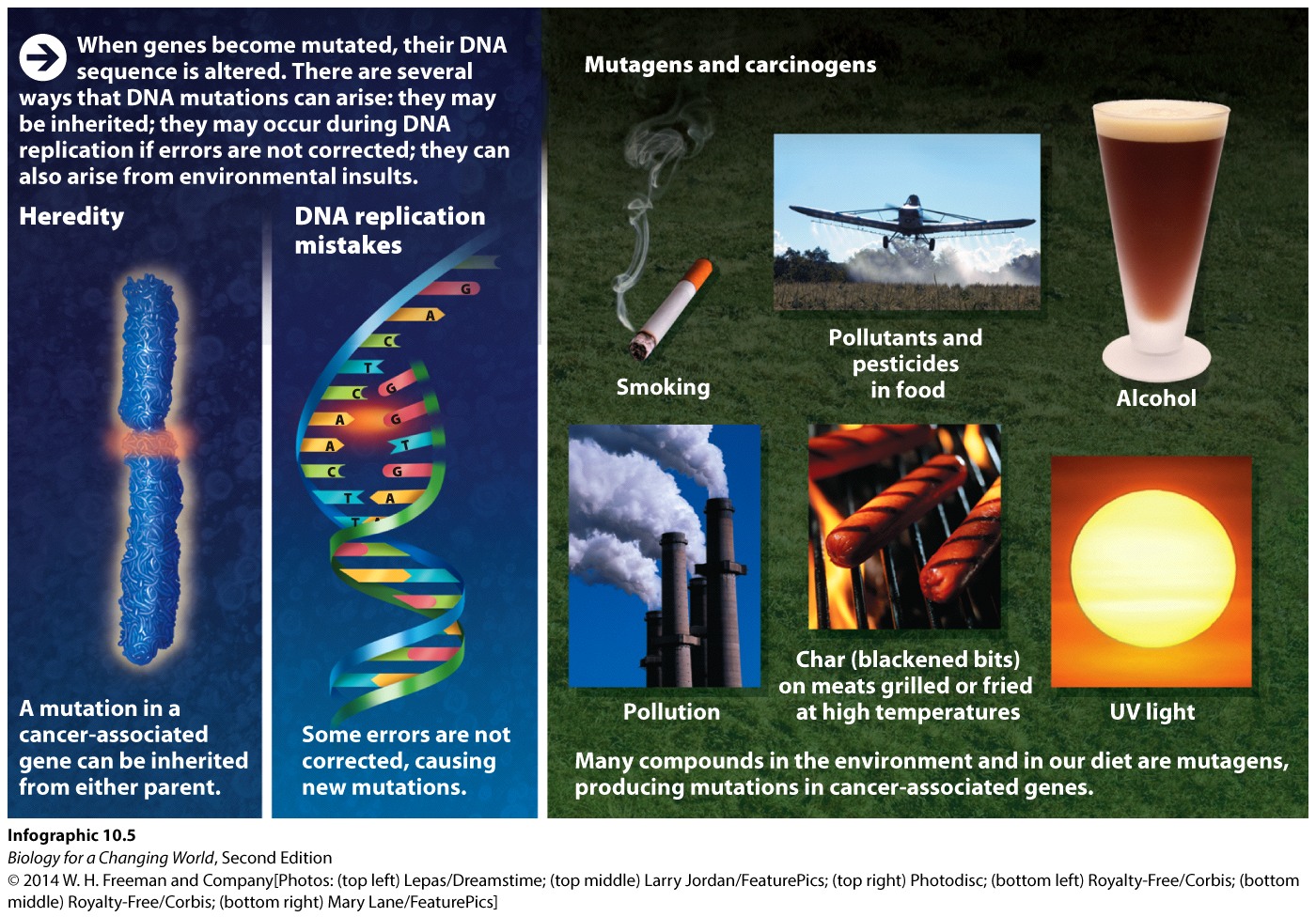
Based on Infographic 10.5, what are the three major ways in which an individual may acquire DNA mutations?
5.
In what ways are these mechanisms similar? How are they different in the respect of when the mutation is present in the person?
6.
Can your personal lifestyle choices affect your likelihood of acquiring DNA mutations? Explain.
Predict whether a mutation in the parent DNA will be inherited by their offspring.
7.
Will a child inherit the following mutations from their parent? Why or why not?
A mutation caused by a chemical that affects the mother’s egg cells.
8.
A mutation in the father’s skin caused by sun damage.
9.
A mutation in the father’s testes caused by gamma radiation that causes the production of more testosterone and thus more sperm cells.
Review Questions
10.
Mutations in DNA can be caused by: (mark "true" for all that are correct)
a. Smoking cigarettes
b. Heredity
c. UV sun tanning beds
d. Char
11.
True or False: Tumor suppressor genes suppress tumors by pausing the cell cycle so a dividing cell can make repairs.
12.
If a mutation occurs during DNA replication in an adult skin cell, is a new allele formed?
| A. |
| B. |
| C. |
| D. |
13.
If a mutation that occurs during DNA replication is not corrected as a sperm cell is generated, is the new allele passed on to the next generation?
| A. |
| B. |
| C. |
| D. |
1.3 Driving Question 2
Driving Question 2
How does cancer develop and how can people reduce their risk?
Why should you care?
Cancer is a disease caused by problems in the cell cycle control mechanisms. Two types of genes control the frequency and timing of cell division. Proto-oncogenes normally control how often a cell divides (often by responding to external signals that initiate division), while tumor suppressor genes – including BRCA1 – typically slow down cell division, repair damaged DNA, and kill cells whose DNA is irreparably damaged. Lorene Ahern’s mutated BRCA1 allele increases her risk of breast cancer because the protein it produces cannot repair damaged DNA. If enough DNA damage accumulates in a group of cells over time, cancer is a likely result.
What should you know?
To fully answer this Driving Question, you should be able to:
- Illustrate and describe the process by which a mutation can cause cancer.
- Compare and contrast the roles of proto-oncogenes and tumor suppressor genes in regulating the cell cycle.
- Explain how mutations in proto-oncogenes and tumor suppressor genes can increase cancer risk.
- List and explain some ways in which people may reduce their cancer risk.
Infographic Focus
The infographics most pertinent to the Driving Question are 10.3, 10.4, 10.5, 10.6 and 10.7 and Table 10.2.
Test Your Vocabulary
Choose the correct term for each of the following definitions:
| Term | Definition |
|---|---|
| A gene that codes for proteins that monitor and check cell cycle progression. When these genes mutate, tumor suppressor proteins lose normal function. | |
| A noncancerous tumor that will not spread throughout the body. | |
| Any chemical agent that causes cancer by damaging DNA. Carcinogens are a type of mutagen. | |
| A mutated and overactive form of a proto-oncogene. Oncogenes drive cells to divide continually. | |
| A mutation occurring in gametes; passed on to offspring. | |
| A gene that codes for a protein that helps cells divide normally. | |
| A change in the nucleotide sequence of DNA. | |
| Any chemical or physical agent that can damage DNA by changing its nucleotide sequence. | |
| A cancerous tumor that spreads throughout the body. | |
| A mutation that occurs in a body (nongamete) cell; not passed on to offspring. |
Illustrate and describe the process by which a DNA mutation can cause cancer.
14.
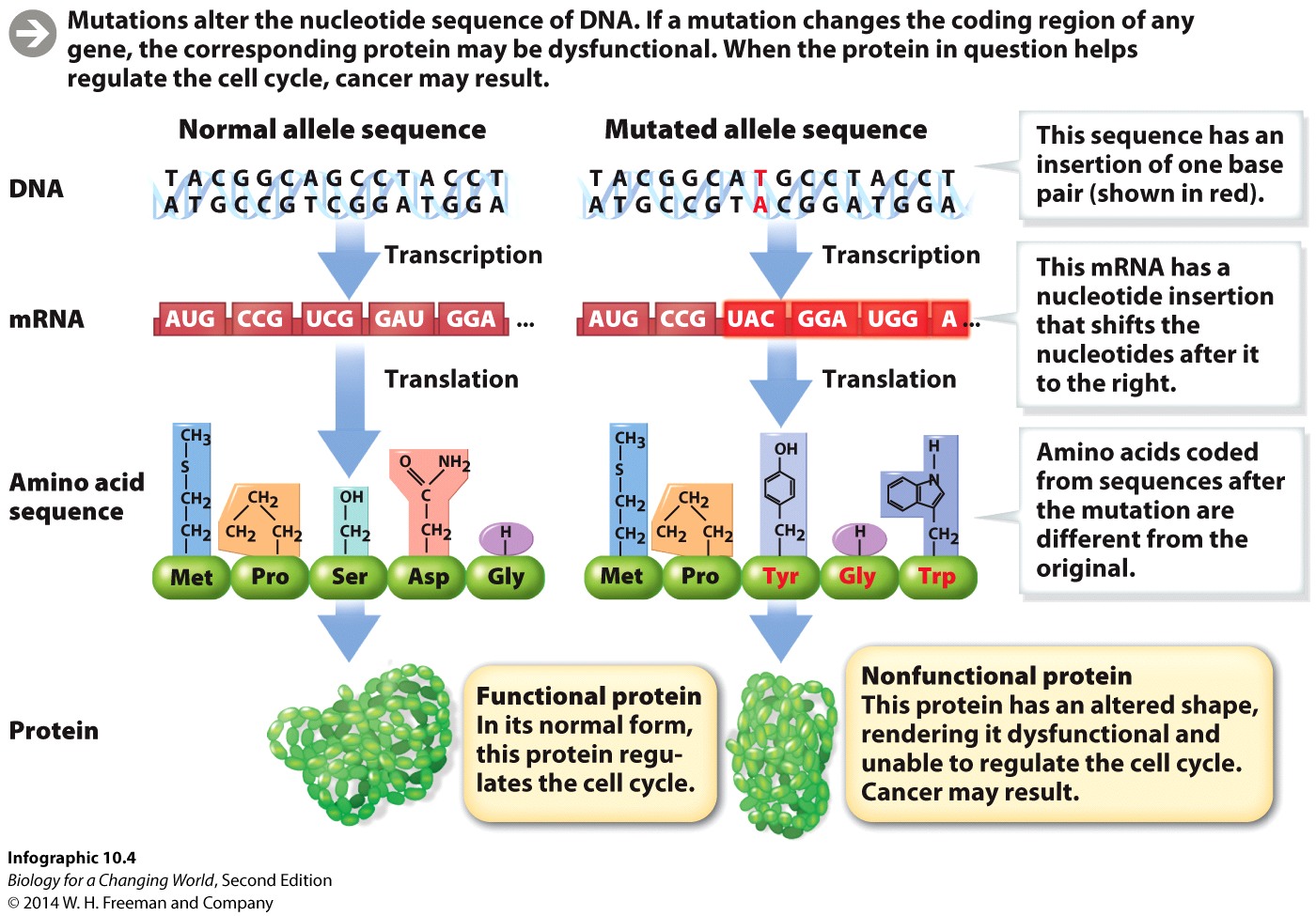
Create your own version of Infographic 10.4 by following these 4 steps:
Copy the normal allele sequence shown in the illustration.
15.
Create your own mutation by inserting a new pair of nucleotides at a site different from the one illustrated.
16.
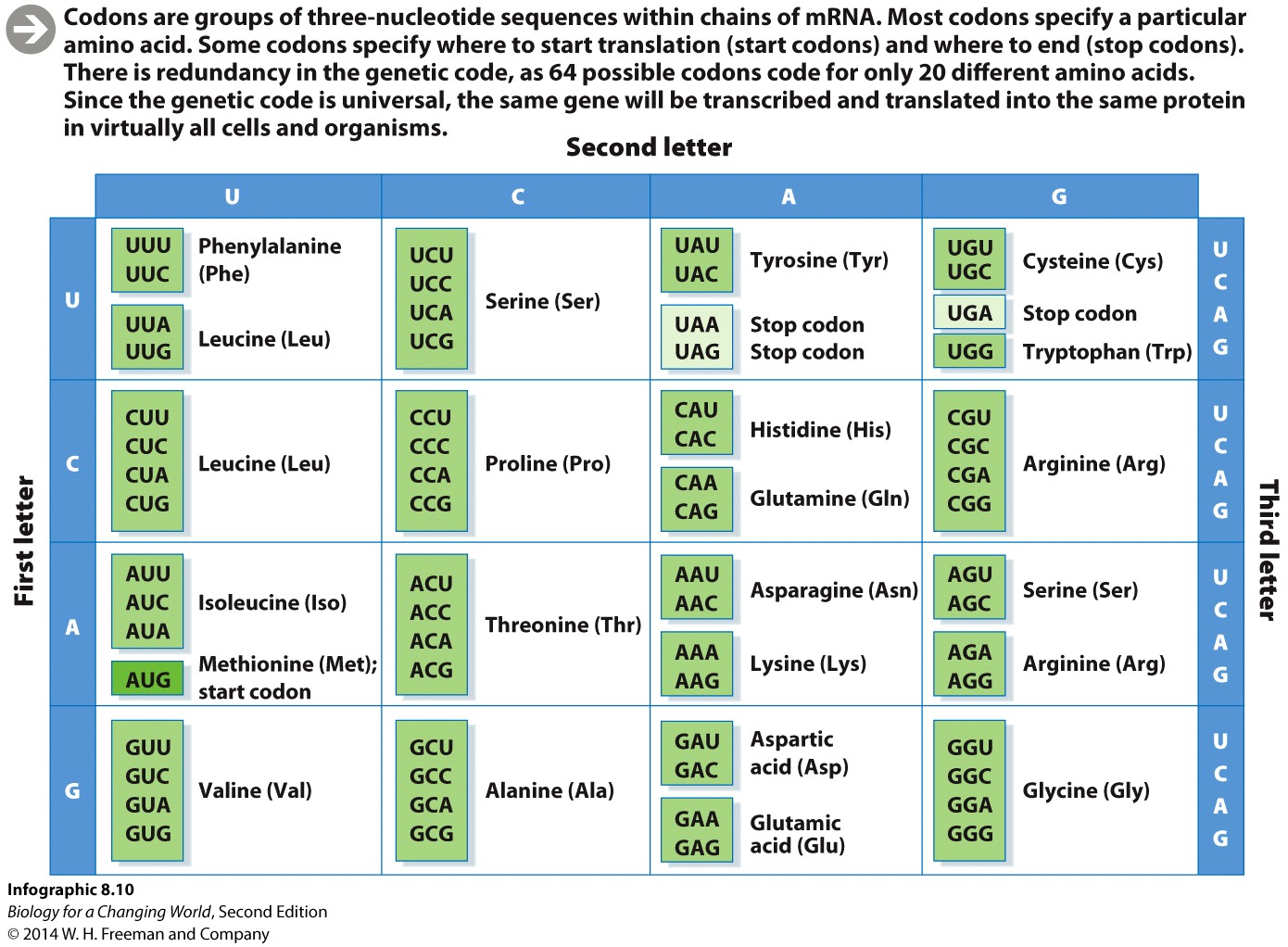
Following the mutated sequence through transcription and translation, use the codon chart from Ch. 8 (Infographic 8.10) to determine your mutated amino acid sequence.
17.
Describe how your mutated protein may cause cancer.
18.
In general, will any mutation that produces a dysfunctional protein increase cancer risk? Explain.
Compare and contrast the roles of proto-oncogenes and tumor suppressor genes in regulating the cell cycle.
19.
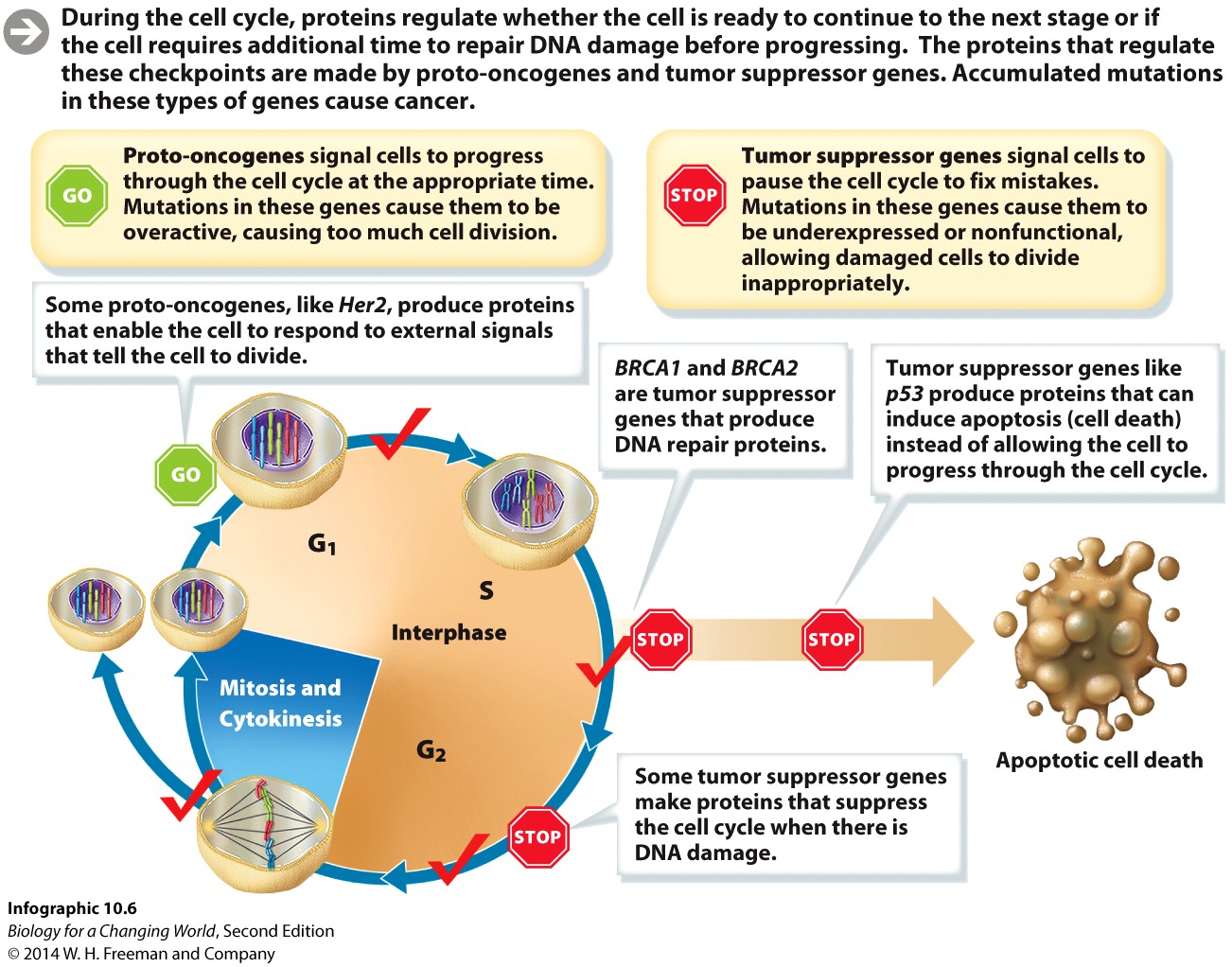
Use Infographic 10.6 to answer the following questions:
Explain why the symbol for proto-oncogenes is a green “go,” while the symbol for tumor suppressors is a red “stop”.
20.
At which point during the cell cycle is a proto-oncogene most likely to operate? Explain your reasoning.
21.
At which point during the cell cycle do BRCA1 and BRCA2 proteins function? Given their function, explain why they operate at this stage of the cycle and not at an earlier or later stage.
Explain how mutations in proto-oncogenes and tumor suppressor genes can increase cancer risk.
22.
What is a mutated proto-oncogene called?
23.
Why do mutated proto-oncogenes increase cancer risk?
24.
Why do mutated tumor-suppressor genes increase cancer risk?
List and explain some ways in which people may reduce their cancer risk.
25.
What are some measures a person can take to reduce their risk of cancer? How do these measures reduce cancer risk?
26.
What are some measures a person can take to reduce their risk of hereditary cancers? How do these measures reduce cancer risk?
Review Questions
27.
The difference in the proteins produced by a normal allele and a mutated allele is:
| A. |
| B. |
| C. |
28.
A person with a hereditary mutation in a tumor suppressor gene would especially benefit from reducing their risk of cancer from environmental factors.
| A. |
| B. |
29.
Avoiding all mutagens and carcinogens will guarantee a cancer-free life.
| A. |
| B. |
1.4 Driving Question 3
Driving Question 3
Why do people with “inherited” cancer often develop cancer at a relatively young age?
Why should you care?
Lorene Ahern’s mutated BRCA1 increases her risk of developing breast cancer. However, it will not cause breast cancer by itself. Cancer cells have many abnormal traits: they divide without normal checks even when crowded, invade nearby tissues, cause new blood vessels to form that supply them with nutrients, and can eventually spread to distant locations in the body. These traits are the products of multiple mutations accumulating over time. For people who inherit high-risk mutations, this time is shorter than normal.
What should you know?
To fully answer this Driving Question, you should be able to:
- Outline the steps involved in a tumor becoming cancerous and explain why more than a single mutation is required.
- Using this model, explain why inherited mutations increase a person’s risk of developing cancer at an earlier age than normal.
Infographic Focus
The infographics most pertinent to the Driving Question are 10.1, 10.5, 10.6, 10.7, and 10.8.
Outline the steps involved in a tumor becoming cancerous and explain why more than a single mutation is required.
30.

Describe the steps outlined in infographic 10.7 by which a tumor may become cancerous by completing the following table:
| Step A | Step B | Step C | Step D | |
| Describe the mutation |
Fill in below:
A single mutation in a tumor suppressor gene associated with DNA repair.
|
Fill in below:
A single mutation in a tumor suppressor gene associated with DNA repair.
|
Fill in below:
A single mutation in a tumor suppressor gene associated with DNA repair.
|
Fill in below:
A single mutation in a tumor suppressor gene associated with DNA repair.
|
| Describe its consequences |
Fill in below:
A single mutation in a tumor suppressor gene associated with DNA repair.
|
Fill in below:
A single mutation in a tumor suppressor gene associated with DNA repair.
|
Fill in below:
A single mutation in a tumor suppressor gene associated with DNA repair.
|
Fill in below:
A single mutation in a tumor suppressor gene associated with DNA repair.
|
31.
Using this scenario, explain why a mutation in a single gene (either a proto-oncogene or a tumor suppressor gene) is unlikely to cause cancer on its own.
Using this model, explain why inherited mutations increase a person’s risk of developing cancer at an earlier age than normal.
32.
Using this model, explain why inherited mutations increase a person’s risk of developing cancer at an earlier age than normal.
33.
Your friend tests positive for a mutation that predisposes them to heart disease. Shortly after, your friend tells you that they are not going to watch what they eat, exercise or avoid high-risk activity because what’s the point? They are going to develop heart disease anyway. What would you tell your friend? Would you support their course of action? Why or why not?
Review Questions
34.
A mutation in a proto-oncogene that causes the protein to be non-functional will lead to cancer.
| A. |
| B. |
35.
Why does a person with an inherited mutation in a proto-oncogene more likely to develop cancer at a younger age?
| A. |
| B. |
| C. |
| D. |
36.
A person who has a mutation in their BRCA2 gene will develop breast cancer at some point in their life.
| A. |
| B. |
Activity results are being submitted...